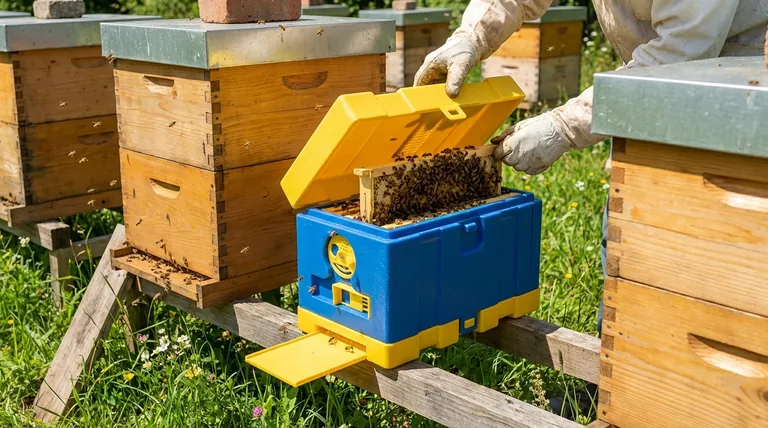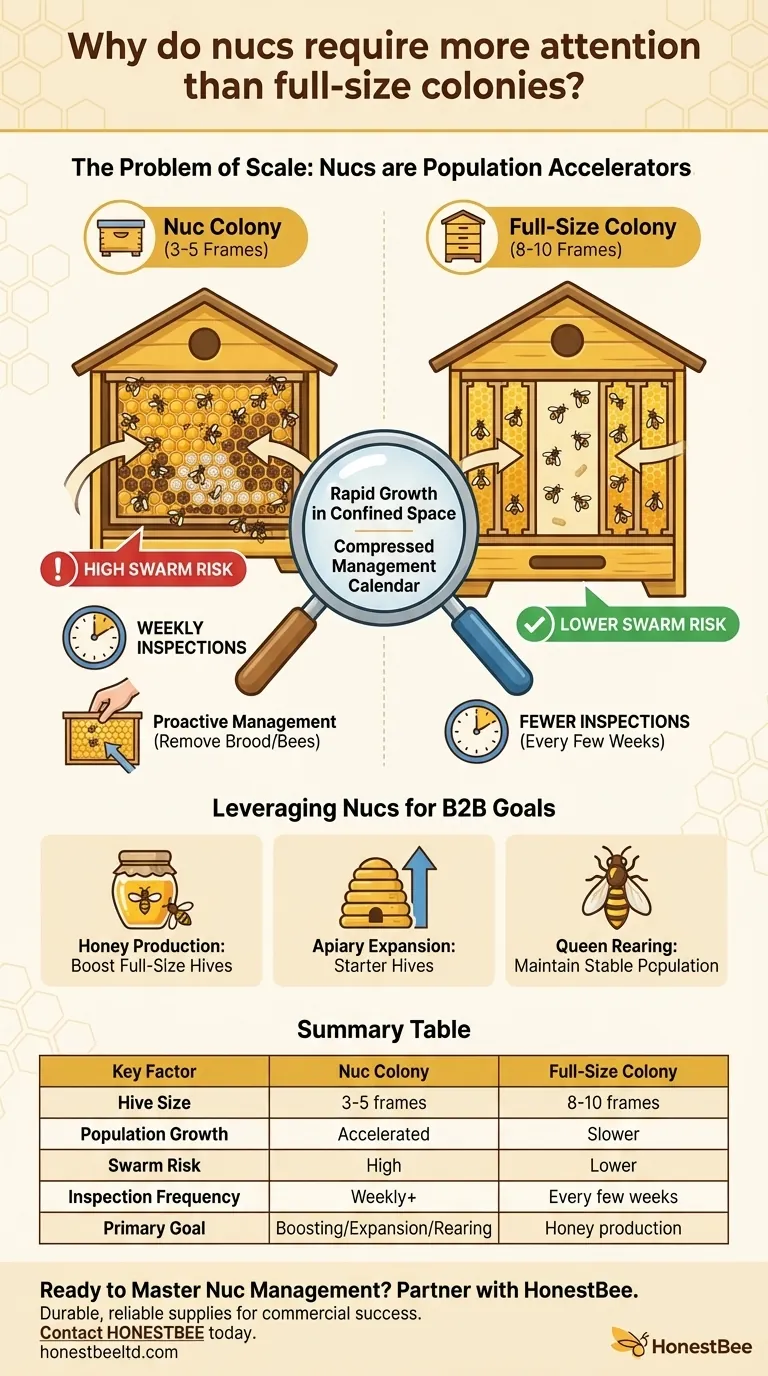At its core, the problem is one of scale. A nucleus colony, or "nuc," requires more diligent attention than a full-size colony because its limited space acts as a population accelerator. A rapidly growing bee population in a small box quickly runs out of room for brood and resources, triggering the colony's natural instinct to swarm far sooner than it would in a larger hive.
The small volume of a nuc is both its greatest strength and its primary management challenge. While it allows for a faster population buildup, it also creates an urgent and frequent need for the beekeeper to manage space to prevent the colony from swarming.

The Core Challenge: Rapid Growth in a Confined Space
A nuc's main characteristic—its small size—is the direct cause of the increased management it requires. Understanding this dynamic is key to keeping your nucs healthy and productive.
What is a Nucleus Colony?
A nuc is simply a small, fully-functional honey bee colony. It has a queen, worker bees, and drones, along with brood and food stores.
The key difference is the equipment. While a standard Langstroth hive holds 8-10 frames, a nuc box typically holds only 3-5 frames.
The Population Accelerator Effect
In the spring, a healthy queen can lay over 1,500 eggs per day. In a large hive, there is ample space to accommodate this expansion.
In a nuc, however, this same rate of growth fills the available frames for brood and food with astonishing speed. The population-to-space ratio changes much more quickly.
The Inevitable Swarm Instinct
Swarming is a honey bee colony's natural method of reproduction. It's triggered when the colony becomes congested and the queen runs out of space to lay her eggs.
Because a nuc becomes congested so rapidly, its swarm instinct is triggered much faster and with more urgency than a full-size colony's. A beekeeper can miss this critical window if not paying close attention.
Common Pitfalls and Management Demands
The accelerated growth cycle of a nuc means that the management calendar is compressed. Tasks that might be done every few weeks on a large hive must be done weekly—or even more frequently—for a nuc during peak season.
Frequent Inspections are Non-Negotiable
A full-size hive often has several frames of buffer space. A nuc has almost none.
During a spring nectar flow, a nuc can go from having adequate space to being "honey bound" or preparing to swarm in as little as a week. This demands consistent and proactive inspections from the beekeeper.
Proactive Population Management
The primary management task for a nuc is to prevent it from outgrowing its box. You cannot simply let it expand indefinitely.
The most common technique is to periodically remove frames of capped brood and bees from the nuc. This relieves population pressure and prevents swarming. These resources are not wasted; they can be used to strengthen weaker, full-size production colonies.
Making the Right Choice for Your Goal
Managing nucs effectively means aligning your actions with your overall beekeeping objectives. Their rapid growth can be either a problem to be managed or a tool to be leveraged.
- If your primary focus is honey production: Use nucs as a support system to constantly boost your full-size hives by donating frames of brood and bees.
- If your primary focus is expanding your apiary: Treat nucs as starter hives, but be prepared to upgrade them to full-size equipment as soon as they have drawn out and are using 70-80% of their frames.
- If your primary focus is queen rearing: Intentionally keep nuc populations low by removing bees, ensuring your valuable queens have ample space and the colonies remain stable without swarming.
Ultimately, successful nuc management is about proactive intervention, turning their rapid growth from a liability into a powerful asset for your apiary.
Summary Table:
| Key Factor | Nuc Colony | Full-Size Colony |
|---|---|---|
| Hive Size | 3-5 frames | 8-10 frames |
| Population Growth | Accelerated, fills space quickly | Slower, more buffer space |
| Swarm Risk | High, triggered rapidly | Lower, triggered over longer periods |
| Inspection Frequency | Weekly or more during peak season | Every few weeks |
| Primary Goal | Boosting hives, apiary expansion, queen rearing | Primarily honey production |
Ready to Master Nuc Management?
Effectively managing your nucleus colonies is key to a thriving apiary. At HONESTBEE, we supply the durable, reliable beekeeping supplies and equipment that commercial apiaries and distributors need to succeed.
Whether you're expanding your operation, rearing queens, or boosting honey production, our wholesale-focused operations ensure you get the right tools for proactive, efficient nuc management.
Let's strengthen your beekeeping strategy together. Contact HONESTBEE today to discuss your equipment needs!
Visual Guide

Related Products
- 4 Frame Plastic Nuc Boxes for Beekeeping Bee Nuc Box
- HONESTBEE Professional Long Handled Hive Tool with Precision Cutting Blade
- Professional Hive Front Entrance Bee Feeder
- Professional Multi-Function Stainless Steel Hive Tool
- Boardman Entrance Bee Feeder Durable Galvanized Steel and Wood Construction for Beekeeping
People Also Ask
- What should a healthy brood nest in a nuc look like? A Guide to Strong Colony Development
- What is the recommended time of year to move bee nucs to a 10-frame hive? A Guide for Apiary Success
- What are the benefits of maintaining a nuc in beekeeping? Gain Control and Resilience for Your Apiary
- What are some uses for a nucleus in beekeeping? A Guide to Apiary Growth and Resilience
- What are nucleus colonies (nucs) and how do they compare to full-size Langstroth colonies?



















